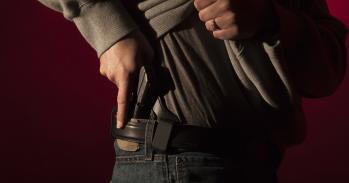
As Obama pledges investment in body-worn-camera technology for police officers, researchers say cameras induce ‘self-awareness’ that can prevent unacceptable uses-of-force seen to have tragic consequences in the US over the past year — from New York to Ferguson — but warn that cameras have implications for prosecution and data storage.
As Obama pledges investment in body-worn-camera technology for police officers, researchers say cameras induce ‘self-awareness’ that can prevent unacceptable uses-of-force seen to have tragic consequences in the US over the past year — from New York to Ferguson — but warn that cameras have implications for prosecution and data storage.
An officer is obliged to issue a warning from the start that an encounter is being filmed, impacting the psyche of all involved by conveying a straightforward, pragmatic message: we are all being watched, videotaped and expected to follow the rules
Barak Ariel
Researchers from the University of Cambridge’s Institute of Criminology (IoC) have now published the first full scientific study of the landmark crime experiment they conducted on policing with body-worn-cameras in Rialto, California in 2012 — the results of which have been cited by police departments around the world as justification for rolling out this technology.
The experiment showed that evidence capture is just one output of body-worn video, and the technology is perhaps most effective at actually preventing escalation during police-public interactions: whether that’s abusive behaviour towards police or unnecessary use-of-force by police.
The researchers say the knowledge that events are being recorded creates “self-awareness” in all participants during police interactions. This is the critical component that turns body-worn video into a ‘preventative treatment’: causing individuals to modify their behaviour in response to an awareness of ‘third-party’ surveillance by cameras acting as a proxy for legal courts — as well as courts of public opinion — should unacceptable behaviour take place.
During the 12-month Rialto experiment, use-of-force by officers wearing cameras fell by 59% and reports against officers dropped by 87% against the previous year’s figures.
However, the research team caution that the Rialto experiment is only the first step on a long road of evidence-gathering, and that more needs to be known about the impact of body-worn cameras in policing before departments are “steamrolled” into adopting the technology — with vital questions remaining about how normalising the provision of digital video as evidence will affect prosecution expectations, as well as the storage technology and policies that will be required for the enormous amount of data captured.
President Obama recently promised to spend $263m of federal funds on body-worn-video to try and stem the haemorrhaging legitimacy of US police forces among communities across the United States after the killing of several unarmed black men by police caused nationwide anguish, igniting waves of protest.
But some in the US question the merit of camera technology given that the officer responsible for killing Eric Garner — a 43-year-old black man suffocated during arrest for selling untaxed cigarettes — was acquitted by a grand jury despite the fact that a bystander filmed the altercation on a mobile phone, with footage showing an illegal ‘chokehold’ administered on Garner who repeatedly states: “I can’t breathe”. (A medical examiner ruled the death a homicide).
For the Cambridge researchers, the Rialto results show that body-worn-cameras can mitigate the need for such evidence by preventing excessive use-of-force in the first place. Data from the Rialto experiment shows police officers are deterred from unacceptable uses-of-force — indeed, from using force in general — by the awareness that an interaction is being filmed; but this ‘deterrence’ relies on cognition of surveillance.
While the evidence provided by the video of Garner’s death would suggest a heinous miscarriage of justice, say researchers, the filming itself by a bystander would not generate the self-awareness and consequent behaviour modification during the incident as observed during Rialto’s institutionalised camera use.
“The ‘preventative treatment’ of body-worn-video is the combination of the camera plus both the warning and cognition of the fact that the encounter is being filmed. In the tragic case of Eric Garner, police weren’t aware of the camera and didn’t have to tell the suspect that he, and therefore they, were being filmed,” said Dr Barak Ariel, from the Cambridge’s IoC, who conducted the crime experiment with Cambridge colleague Dr Alex Sutherland and Rialto police chief Tony Farrar.
“With institutionalised body-worn-camera use, an officer is obliged to issue a warning from the start that an encounter is being filmed, impacting the psyche of all involved by conveying a straightforward, pragmatic message: we are all being watched, videotaped and expected to follow the rules,” he said.
“Police subcultures of illegitimate force responses are likely to be affected by the cameras, because misconduct cannot go undetected — an external set of behavioural norms is being applied and enforced through the cameras. Police-public encounters become more transparent and the curtain of silence that protects misconduct can more easily be unveiled, which makes misconduct less likely.” In Rialto, police use-of-force was 2.5 times higher before the cameras were introduced.
The idea behind body-worn-video, in which small high-definition cameras are strapped to a police officers’ torso or hat, is that every step of every police-public interaction — from the mundane to those involving deadly force — gets recorded to capture the closest approximation of actual events for evidence purposes, with only case-relevant data being stored.
In Rialto, an experimental model was defined in which all police shifts over the course of a year were randomly assigned to be either experimental (with camera) or control (without camera), encompassing over 50,000 hours of police-public interactions.
The dramatic reduction in both use-of-force incidents and complaints against the police during the experiment led to Rialto PD implementing an initial three-year plan for body-worn cameras. When the police force released the results, they were held up by police departments, media and governments in various nations as the rationale for camera technology to be integrated into policing.

Ariel and colleagues are currently replicating the Rialto experiment with over 30 forces across the world, from the West Yorkshire force and Northern Ireland’s PSNI in the UK to forces in the United States and Uruguay, and aim to announce new findings at the IoC’s Conference for Evidence-Based Policing in July 2015. Early signs match the Rialto success, showing that body-worn-cameras do appear to have significant positive impact on interactions between officers and civilians.
However, the researchers caution that more research is required, and urge police forces considering implementing body-worn-cameras to contact them for guidance on setting up similar experiments. “Rialto is but one experiment; before this policy is considered more widely, police forces, governments and researchers should invest further time and effort in replicating these findings,” said Dr Sutherland.
Body-worn cameras appear to be highly cost-effective: analysis from Rialto showed every dollar spent on the cameras saved about four dollars on complaints litigations, and the technology is becoming ever cheaper. However, the sheer levels of data storage required as the cameras are increasingly adopted has the potential to become crippling.
“The velocity and volume of data accumulating in police departments — even if only a fraction of recorded events turn into ‘downloadable’ recordings for evidentiary purposes — will exponentially grow over time,” said Ariel. “User licenses, storage space, ‘security costs’, maintenance and system upgrades can potentially translate into billions of dollars worldwide.”
And, if body-worn cameras become the norm, what might the cost be when video evidence isn’t available? “Historically, courtroom testimonies of response officers have carried tremendous weight, but prevalence of video might lead to reluctance to prosecute when there is no evidence from body-worn-cameras to corroborate the testimony of an officer, or even a victim,” said Ariel.
“Body-worn-video has the potential to improve police legitimacy and enhance democracy, not least by calming situations on the front line of policing to prevent the pain and damage caused by unnecessary escalations of volatile situations. But there are substantial effects of body-worn-video that can potentially offset the benefits which future research needs to explore.”
Inset image: screenshot taken from a West Midlands (UK) officer's body-worn-camera.
More information:
Ariel, B. et al. The Effect of Police Body-Worn Cameras on Use of Force and Citizens’ Complaints Against the Police: A Randomized Controlled Trial. Journal Quantitative Criminology (Nov. 19, 2014)
Read Dr Barak Ariel and Dr Alex Sutherland discuss the Rialto experiment and the future of body-worn-cameras on The Conversation US.
The text in this work is licensed under a Creative Commons Licence. If you use this content on your site please link back to this page. For image rights, please see the credits associated with each individual image.





